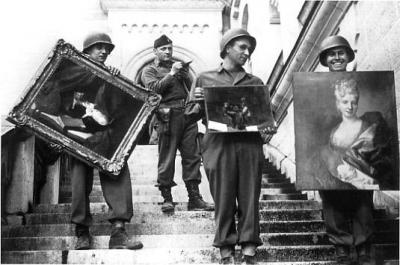Post I : The Protection of Cultural Heritage : An Obligation
By Audrey Weiss and Fiana Gantheret
Looting and destruction of one people’s cultural identity has been the norm in wars since the dawn of civilisation. For all that, the development of the international legal framework, in close collaboration with regional organisations – see the adoption in 2017 of the European Council Convention on Offenses relating to Cultural Properties -, as well as of international justice up until the Al-Mahdi case at the International Criminal Court (ICC), reminds us of the increased importance given to the protection of cultural artefacts over the past century, for they constitute the heritage of humanity.
As a sign of this increasing emergency in protecting cultural heritage from attacks in times of conflict, Fatou Bensouda, Prosecutor of the ICC, and Irina Bokova, Director-General of the United Nations Educational, Scientific and Cultural Organization (UNESCO) signed, on November 6, 2017, a Letter of Intent, formalizing and further strengthening their collaboration in this matter. Cultural heritage is highlighted in the Letter as a “celebration of our commonality and the richness of our diversity”, and Prosecutor Bensouda noticed that destruction of cultural property has devastating impacts on dignity and further human rights, including freedom of thought, conscience and religion, the right to education and even economic rights and she therefore underlined the necessity to address these crimes through the law. A Letter of Intent solidifying the existing relationship between UNESCO and the ICC and responding to a “humanitarian and security imperative”, stated Ms Bokova.
Creating Rights will offer a series of blogposts over the next few weeks with the aim to give an overview of the international legal framework ensuring the protection of cultural artefacts and sites through States obligations (post I), a reflexion on the protection of cultural heritage as a cultural right (post II), and a description of the stakes at play within the criminalisation of the destruction of cultural properties, as envisioned by the international justice system. In this last post, an overview of the Al-Mahdi case at the ICC as well as the reparation system of the Court applied in the particular contexts where a conviction has been issued in relation to attacks against buildings dedicated to art and historic monuments will also be given (post III). Finally, the question of the reconstruction and its importance for the conflict-affected communities will be studied in a final post (post IV).
Post I : The Protection of Cultural Heritage : An Obligation
In this first blog post on cultural heritage, Creating Rights will set out the important work that has been done over the years by the international community, through several conventions drafted with the purpose to respond to the destruction of cultural heritage. They thereby developped the nature and dimension of the notion of cultural heritage to include in its definition intangible artefacts, as well as the strong link existing between the cultural productions of men and their right to enjoy it.
The destructions caused by World War II led not only to the creation of UNESCO, on November 16, 1945, but also to cooperation within the international community and a will to elaborate multilateral treaties in order to preserve cultural properties, for the benefit of present as well as future generations. By doing so, the international community expanded on the possibilities contained in this seemingly simple word, « heritage » : something which is passed down.
According to the UNESCO, cultural heritage is “the legacy of physical artefacts and intangible attributes of a group or society that are inherited from past generations, maintained in the present and bestowed for the benefit of future generations. Cultural heritage includes tangible culture (such as buildings, monuments, landscapes, books, works of art, and artifacts), intangible culture (such as folklore, traditions, language, and knowledge), and natural heritage (including culturally significant landscapes, and biodiversity).”
The Convention for the Protection of Cultural Property in the Event of Armed Conflict, adopted in The Hague in 1954 (the 1954 Hague Convention), is the first international treaty formulating rules to protect cultural heritage during armed conflicts. It regulates the conduct of nations during war and military occupation in order to guarantee the protection of cultural sites, monuments and repositories, including museums, libraries and archives. This Convention is the oldest international agreement to address exclusively cultural heritage preservation. It is interesting to note the references made in the Preamble of the Convention to “people” and not “States”, as a way to underline the interconnection between all human beings through cultural heritage :
“Being convinced that damage to cultural property belonging to any people whatsoever means damage to the cultural heritage of all mankind, since each people makes its contribution to the culture of the world”.
As analysed by Francesco Francioni in the European Journal of International Law, these statements justify the general obligation of the States to respect – namely to abstain from « acts of willful destruction and damage » – cultural heritage of significant importance in the event of armed conflict. Each individual being the carrier of the cultural heritage of humanity, attacks on cultural sites in one country is made equivalent to destroying the cultural heritage of humanity as a whole.
A First Protocol to the 1954 Hague Convention has been drafted and opened to ratification the same year. It provides specific guidelines for the import and export of cultural property from an occupied territory during armed conflict, and the return of such objects when held in protective custody abroad. In 1999, the Second Protocol to the 1954 Hague Convention was adopted, and entered into force in March 2004. The Second Protocol supplements the 1954 Hague Convention by taking into account developments in warfare since the post-World War II period, especially the type of ethnic conflict that erupted in the former Yugoslavia. As noted by Tonka Kostadinova, “(b)elligerents in the Yugoslav wars sought to justify their own existence and to (re)define territories by demolishing or suppressing the identity of ‘the other’”. The Second Protocol was designed to address the intentional destruction of cultural heritage. It strengthens several provisions of the 1954 Hague Convention concerning the safeguarding of and the respect for cultural property and conduct during hostilities. The Second Protocol also creates a differentiation in gravity for offences against cultural property by referring to two types of offences. Those committed against property under enhanced protection entail more serious consequences.
The UNESCO General Conference also adopted a Declaration concerning the Intentional Destruction of Cultural Heritage, later on, in 2003. This time, the Declaration applies in the context of armed conflict, occupation and in time of peace, but does not create legal obligations upon States.
Another important convention in favour of cultural heritage protection, and the valorization of its relationship to the human life, is the Convention concerning the Protection of the World Cultural and Natural Heritage that was adopted in Paris on November 16, 1972. It contains the innovative concept of “world heritage”, dedicated to cultural and natural properties of outstanding universal value.
A last example of a treaty framing the protection of cultural heritage (a comprehensive list of treaties can be found here, as well as on the Peace Palace Library website, which offers a very interesting research guide to the topic of cultural heritage), is the Convention for the Safeguarding of Intangible Cultural Heritage, signed in 2003 in Paris, concerning peacetime. The safeguarding of “living cultures” has emerged in the past decade as one of the new dimensions of cultural heritage law, since the notion of “cultural heritage of all mankind” has been criticized for being conceived only under its intangible aspect (buildings, monuments, paintings etc), in accordance with the western conception of cultural heritage. Therefore, claims, coming especially from Latin America, have emerged from ethnic minorities and indigenous people for international law to conceive cultural heritage also in its immaterial expression (i.e. traditional cultures, folklores) that involves the heritage of communities unrepresented by a State. The Convention for the Safeguarding of Intangible Cultural Heritage is the first binding instrument to extend the scope of international protection from intangible cultural property to oral and immaterial heritage. The Convention highlights the link between protection of cultural heritage and human rights, in particular with the collective dimension of the right to access, perform and maintain a group’s culture and the right to choose a cultural identity.
Through the development of the international legal framework, the link between cultural heritage and human identities, traditions, and history, became stronger. Cultural artefacts represent the expressions of human creativity and skills. The destruction of items forming our cultural heritage hence infringes upon several rights universally recognized, such as “the right to freedom of thought and religion, the right to freedom of expression, including the right to learning about your history and the history of others”, as underscored by Karima Bennoune, the UN Special Rapporteur in the field of cultural rights, in a discussion organised in October 2016 by the United Nations and gathering experts with a view to explore the relationship between cultural heritage and human rights. This question will be the topic of the next blog post of the series concerning cultural heritage on Creating Rights‘ website.
Featured image visible here and here. Monuments, Fine Arts, and Archives (MFAA) Officer James Rorimer supervises U.S. soldiers recovering looted paintings from Neuschwanstein Castle in Germany during World War II. The provision in the 1954 Hague Convention to have trained military personnel within a nation’s armed forces was inspired by the successful example of the MFAA. (U.S. National Archives and Records Administration).






